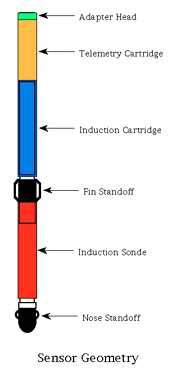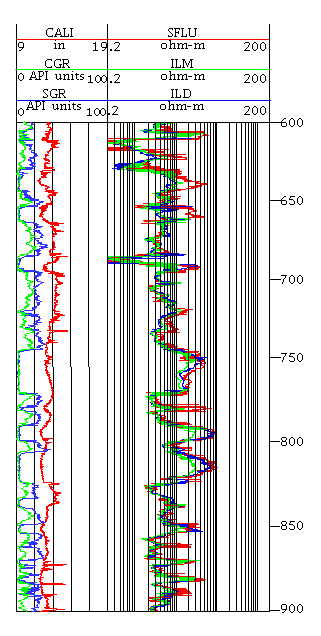Phasor Dual Induction-Spherically Focused Resistivity Tool (DIT*)
Description
In homogeneous formations with resistivity higher than 100 ohm m the average radial depth of investigation is about 5 ft (1.5 m) and 2.5 ft (76 cm) for the deep and medium induction curves, respectively, and 1.25 ft (38 cm) for the SFL. This drops to 4 ft (122 cm) and 2.2 ft (66 cm) at 0.1 ohm-m resistivities.
The thin bed resolution over a full range of formation conductivities has been greatly improved, due to an enhanced signal processing technique and real time correction for the effect of adjacent formations (shoulder effect).
Applications
Porosity. In sediments that do not contain clay or other conductive minerals, the relationship between resistivity and porosity has been quantified by Archie’s Law. Archie’s Law relates the resistivity to the inverse power of porosity. This relationship has also been used to estimate apparent porosity in oceanic basalts.
Density and velocity. Archie’s equation has been used effectively to create “pseudodensity” and/or “pseudovelocity” logs from porosity over intervals where no such logs were recorded or were totally unreliable. In some instances velocities derived from resistivity logs can be used to depth-tie seismic reflectors.
Lithologic boundaries and textural changes. Resistivity, along with acoustic and velocity logs, is a very valuable tool in defining lithologic boundaries over intervals of poor core recovery. In a particular example, the decrease in resistivity toward the top of a carbonate unit, coupled with a decrease in velocity, allowed one to interpret this unit as a fining-upward sequence in mostly carbonatic sediments. Similar saw-tooth patterns in the resistivity response can also be observed in oceanic basalt units where they are related to porosity changes towards the top of each unit.
Environmental Effects
The Phasor Dual Induction tool provides a set of corrections for different environmental effects, which can be performed in real time during logging. These include corrections for adjacent formations, borehole signal, and invasion. In general, invasion is not a problem in the boreholes logged in the Integrated Ocean Drilling Program, because seawater is used as drilling fluid, but it can occur in land wells. In fact, depending on the type of drilling mud used and on the permeability of the formation, invasion of the mud filtrate into the formation adjacent to the borehole can lead to differences in the response of shallow and deeper resistivity devices. On the other hand, invasion can provide useful information about formation permeability and pore fluid electrical conductivity. Differences in the temperature of drilling fluid compared to undisturbed formation temperatures can also generate this effect, as conductivity in ionic fluids such as seawater is strongly temperature dependent.
Log Presentation
Deep (ILD or IDPH) and medium (ILM or IMPH) induction, and spherically focused resistivity (SFLU), are usually plotted in ohm-m on a logarithmic scale along with gamma ray and caliper logs.
Tool Specifications
| Temperature rating: | 350° F (175° C) |
| Pressure rating: | 20 kpsi (138 MPa) |
| Diameter: | 3.375 in (9.21 cm) |
| Length: | 31 ft (9.5 m) |
| Weight: | 445 lbs (201.9 kg) |
| Sampling interval: | 6 in (15.24 cm) |
| Max. logging speed: | 0,000 ft/hr (3,048 m/hr) |
Measurement Specifications
| Vertical resolution: | 5-6 ft (1.5-1.8 m), medium induction
7-8 ft (2.1-2.4 m), deep induction logs 3 ft (92 cm), spherically focused log. |
| Depth of investigation: | (See discussion in “Description” section) |
| Measurement range: | 0-150 ohm-m |
Major Outputs
| ILD: | Deep induction (ohm-m) |
| ILM: | Medium induction (ohm-m) |
| IDPH: | Phasor deep induction (ohm-m) |
| IMPH: | Medium deep induction (ohm-m) |
| SFLU: | Spherically focused log (ohm-m) |
Deployment Notes
Typically run with APS, HLDS, and HNGS, the DIT can be replaced by the DLL or HRLA. The DIT has an internal temperature measurement which may be useful in high temperature environments.
* ®trademark of Schlumberger


